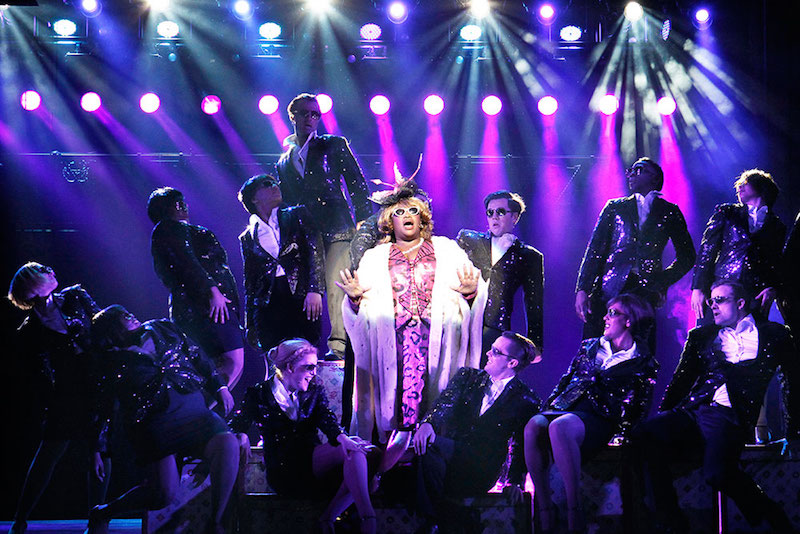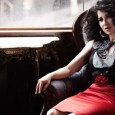Audiences expecting earnest retro cheesiness and zero subtlety will be satisfied by the production of Ghost the Musical, currently playing at Sydney’s Theatre Royal. New York banker Sam (Rob Mills) and girlfriend Molly’s (Jemma Rix) romance is put to the test when Sam is murdered. Based on the 1990 film—the highest grossing movie of the year—the romantic thriller interrogates how love can live on after death.
One of the production’s main draw cards is Idol heartthrob turned musical theatre go-getter Rob Mills. Although it’s a stretch to buy him as a banker, Mills proves himself to be a pleasing male lead. He captures Sam’s slick yet honest persona, brings a surprising weight to his solos, and lays on the charm during his guitar serenade of Molly to “Unchained Melody”. My plus one and I couldn’t help but wonder if Season Four Australian Idol winner Damien Leith—the Idol alumni first famous for singing the Righteous Brothers’ tune—was sobbing silently in the back row during Milsy’s reclamation of the hit.
Sam also wins the award for most unexpected moment to break into song. According to Sam, the natural reaction to finding a thug self-pleasuring himself to a photograph of your widow is, of course, to sing your heart out.
As Molly, Wicked star Jemma Rix ticks all the right boxes. Her vocal range and control is impeccable, and her acting tugs on the audience’s heartstrings with surgical precision. Despite Molly’s moving ballads, the role itself is slim. True, Molly has a promising pottery career but once Sam passes on, she has little to do beside mourn his loss. “You took my life with you, took my world with you,” she laments. Even the ghost has more agency than Molly—it is Sam, in spectre form who not only tracks down his killer but foils a corruption conspiracy.
The set design is visually impressive but lacks a cohesive creative vision. A few choice furnishings bring us from Sam and Molly’s love nest, to an inner-city bank, to a grimy New York subway. Footage projected onto a screen does the heavy lifting to sketch out crowded skylines and evoke the rapid pace of the Big Apple. But at times these visuals play out like stock footage. The biggest letdown? The wall of photographs of Molly and Sam in their apartment, which looks like Milsy and Jemma Rix were let loose with a selfie stick before the show.
And while these projected images reflect the transparency of Sam’s ghostly figure, it leaves the bare bones set feeling empty at times, especially when viewed from the dress circle. (For a masterclass on animation and live performance, see 1927’s Golem at Sydney Theatre Company instead—for half the price.)
The songs from Dave Stewart (of the Eurythmics) and Glen Ballard are not memorable and often too literal, further accentuated by the heavy-handed direction of some musical numbers. During the chorus’s first song, Wall Street big shots dance around in corporate attire and explain how New York is a city of excess. Who would have thought? Matrix-style binary code is projected behind them, and the point is furthered laboured by the words “MORE, MORE, MORE” projected behind them. Chris Lilley’s Mr G would not be out of place on stage, dressed as a $100 bill.
Sam’s friend and co-worker Carl (David Roberts) is seduced by this world of excess, double-dealing and accidental murder. Roberts fills the stage with both his strong vocals and solid performance, although his tell-tale cocaine sniffle in every scene to remind us of his descent into drugs and corruption (remember: MORE AND MORE AND MORE!) is a little on the nose.
The action picks up when genuine psychic turned racketeer, Oda Mae Brown, who serves as a liaison between Sam and the world of the living, is introduced. Wendy Mae Brown (from the British touring cast of Ghost) triumphs in the comic role made famous by Academy Award winner Whoopie Goldberg. Mae Brown, quite simply, is electric—as are her costumes. Her voice raises the roof of the Royal Theatre, and she milks every line for laughs.
The weak link in the cast is the chorus: their dancing lacks sharpness, and the choreography flatlines. The pottery scene is another letdown of the night. It is difficult to rival the original depiction of Patrick Swayze and Demi Moore’s hands intertwined around a lump of clay, with more sexual chemistry than the film’s M rating belies. But in the live musical, this iconic scene lasts mere moments. Black and white footage of the couple embracing is projected above the action, which distracts even further.
Admittedly, for those who have lost a loved one, the production does offer a comforting message about our relationships with those who have passed on. The woman sniffling next to me seemed to be touched by the emotion, or at the very least, the spectacle of emotion.
But the final product of Ghost the Musical is akin to a McDonald’s soft serve: sweet, simple, somewhat satisfying. The musical will certainly appeal to fans of the original film, although it did screen on television this month. Let’s hope it’s sitting on your DVR instead.





